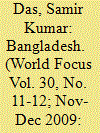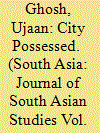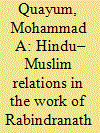| Srl | Item |
| 1 |
ID:
093324


|
|
|
| 2 |
ID:
188403


|
|
|
|
|
| Summary/Abstract |
The mid twentieth-century Bengali ghost story has a distinct urban form. From haunting Gothic mansions, ominous bungalows and thickets of trees, the ghosts of mid twentieth-century fiction show up in the streets of Calcutta, on motorised omnibuses, in urban movie theatres and even selling cocaine in the docks of the city. In this paper, I explore why Bengali ghost stories in the twentieth century predominantly choose the city as a motif to situate their hauntings. I analyse two spectral texts from the mid twentieth century, ‘Kankal Sarathi (The Skeleton Chauffeur)’ by Hemendra Kumar Ray (1888–1963) and ‘Andhakre (In Darkness)’ by Sharadindu Bandyopadhyay (1899–1970), and juxtapose them alongside the official urban archive. Significant changes took place in Calcutta’s urban planning at the turn of the twentieth century. Committed to ‘improving’ the city, planners sought large-scale demolitions of existing buildings, which resulted in massive displacement of individuals and communities. Historians have recorded the deep disquiet these changes induced in the city’s inhabitants. What I demonstrate are the ways in which ghost stories responded to these infrastructural alterities. Spectral narratives emerged as a new literary strategy through which the city’s new journey towards infrastructural modernity was critiqued. The larger methodological question I wish to explore is whether it is possible to treat the genre of horror as an extended archive of historical inquiry.
|
|
|
|
|
|
|
|
|
|
|
|
|
|
|
|
| 3 |
ID:
140099


|
|
|
|
|
| Summary/Abstract |
Rabindranath Tagore (1861–1941) and Rokeya Sakhawat Hossain (1880–1932) are two stalwarts of twentieth century Bengali literature. Born and raised in very different socio-cultural and religious environments, both lacked formal education, yet both went on to become ardent champions of education. Despite their different religious identities, both writers stepped out of their cultural and gendered borders to embrace the ‘other’ in a spirit of fellowship and unity, against a backdrop of turbulent Hindu–Muslim relationships and recurrent communal riots, throughout most of their adult lives. The present article investigates this cross-cultural, dialogic-inclusive vision of Hindu–Muslim unity as reflected in the literary works of these two writers. It seeks to explain why and how they espoused such a bold vision, going against the grain of religious feuds that characterised the history of the period. The current relevance of such cross-cultural navigation is evident.
|
|
|
|
|
|
|
|
|
|
|
|
|
|
|
|